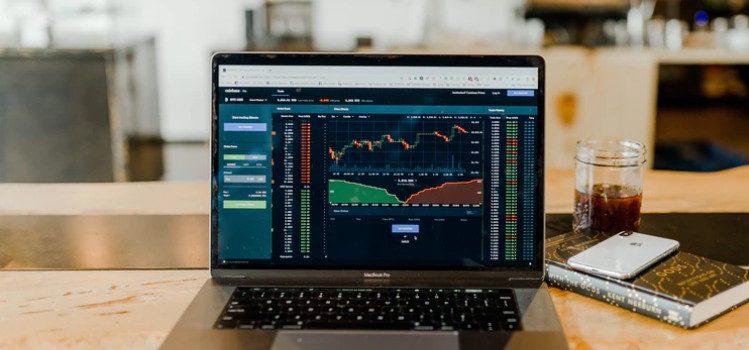

This article is an excerpt from the Shortform book guide to "Flash Boys" by Michael Lewis. Shortform has the world's best summaries and analyses of books you should be reading.
Like this article? Sign up for a free trial here .
How does front-running stocks work? Why is the practice of front-running prohibited in the financial market?
If you’re front-running stocks, you’re technically manipulating the market into giving you private or insider information. In Flash Boys, Michael Lewis goes into depth on the concept to educate readers on why it’s a dishonorable way of trading stocks.
Here’s Lewis’s easy-to-understand breakdown of front-running stocks, including three versions of the practice that high-frequency (HF) firms and investors use.
Front-Running Stocks: A Breakdown
Lewis describes front-running as a high-frequency trading (HFT) tactic. It’s when traders use advanced knowledge of an impending trade to capitalize on that trade. The main goal of front-running stocks is to gather information—about stocks, the market, and investors—that other traders don’t know and then to use that information to make smarter trading decisions.
Traders who know a stock is about to be bought or sold can buy or sell that stock for themselves and can buy or sell that stock for a better price. For example, if you know that another trader is about to buy a large quantity of Apple stock, you’ll know that the value of Apple stock is about to increase in price. The demand has increased, meaning the price will probably increase as well. You use this knowledge to buy Apple stock before the other trader, while the stock is at a lower price. Then, when the price rises, you can sell it for a profit.
Lewis contends that HF traders use versions of front-running to gather information about regular investors and other traders. Then they use this information to make educated decisions about profitable stock orders. We’ll discuss three versions of HFT front-running: rebate baiting, electronic front-running, and information baiting.
| Gray Areas of Front-Running While Lewis describes front-running stocks as using insider knowledge to make unfairly advantageous trades, the issue isn’t as black and white as he makes it seem. There are types of front-running that aren’t illegal, such as index front-running. Index front-running happens when companies are added or removed from an index fund, such as the S&P 500, which manages large collections of stocks. When this information is announced, traders can buy or sell stocks of that company that will be beneficial to them. It’s not illegal to do this since the information is available to anyone looking for it. This is why some critics don’t agree that HF traders are front-running simply because they receive public information faster than other traders. However, reports revealed that HF traders bought direct access to market data, giving them advanced knowledge over other traders, which could be considered a form of front-running. |
Rebate Baiting
Lewis describes rebate baiting as a form of front-running, which is when an HF trader monitors an exchange where human brokers are more likely to send their orders first because they’ll get a rebate. The HF traders use this information to front-run the order to other exchanges that haven’t received it.
(Shortform note: Because rebates may create a conflict of interest for brokers when sending out customer orders, regulators are reevaluating rebate effectiveness. Under Europe’s MiFID II, most forms of rebates are banned to increase transparency about what investors pay for when working with brokers. This regulation could inspire US regulators to also eliminate rebates, as the absence of incentives may not negatively affect markets and could reduce the chance of rebate baiting.)
Electronic Front-Running
Lewis notes that while the new trading regulation (Reg NMS) was intended to protect investors by offering the best stock prices, it allowed HF traders to use the rules against investors through electronic front-running, which is when an HF trader spots a broker trying to trade at one exchange and—using this information—races to another exchange to beat him to that particular stock. Then the HF trader buys or sells it to the broker—who isn’t as fast as the HF trader—for a profit.
Lewis notes that Reg NMS mandates that traders buy stocks at the best (lowest) market price. But the regulation doesn’t guarantee that the exchange with the lowest stock price will have the exact number of shares an investor wants. Thus, a broker might have to go to multiple exchanges to fulfill an investor’s entire order. When he does this, his order tips off HF traders of his intentions to buy or sell a certain stock. The HF traders can then race to other exchanges to buy the stock he wants, only to sell it to him at a higher price.
Could Replacing Reg NMS Solve Electronic Front-Running?
Other experts agree with Lewis’s argument that traders have found ways to exploit well-intentioned regulations, such as Reg NMS, providing HFT with avenues to front-run stock investors. Some experts even recommend replacing Reg NMS with an entirely new—albeit more relaxed—regulation. One suggestion is to outline several factors—not just price—that a broker must consider when executing customer trade orders, such as:
- The price of the stock
- How secure the market is at the time of purchase
- The size of the transaction
- The type of transaction
- The number of markets researched
- How easily the transaction can be fulfilled
Experts argue that by considering more factors of a trade, investors would get a more satisfactory deal, as their trade would be customized to them and their preferences instead of just price. However, as with Reg NMS, this well-intentioned regulation may lay the groundwork for other kinds of investor exploitation as traders find new ways to scheme the markets.
Order-Type Baiting
Lewis explains that another front-running stocks strategy is order-type baiting, or when an HFT examines different order types—and the parameters that accompany them—to figure out the intentions of an investor. So, for example, an HF trader’s order type might alert an HF trader that an investor withdraw an order if another broker doesn’t act on it. If a broker does act on the order, HFT uses this information to front-run their order to other exchanges, forcing the investor to pay a higher price.
Because of order-type baiting, HFT accounted for 99% of all orders made, but only half of all completed trades. Lewis believes that most of the orders HF traders made were used to get as much information about investors (and their intentions to buy or sell) as possible, thus hurting ordinary investors.

———End of Preview———
Like what you just read? Read the rest of the world's best book summary and analysis of Michael Lewis's "Flash Boys" at Shortform .
Here's what you'll find in our full Flash Boys summary :
- Why high-frequency trading (HFT) is a threat to your investments
- A look at Wall Street’s greedy response to HFT
- How Canadian trader Brad Katsuyama tried to fight the problem






